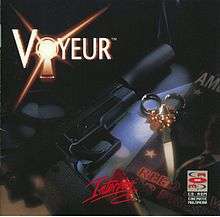Voyeur (video game)
| Voyeur | |
|---|---|
|
Cover art | |
| Developer(s) | Philips POV Entertainment Group |
| Publisher(s) |
Philips Interactive Media (CD-i version) Interplay (MS-DOS version) MacPlay (Mac OS version) |
| Director(s) | Robert Weaver |
| Designer(s) | David Riordan |
| Composer(s) | Garry Schyman |
| Platform(s) | CD-i, DOS, Mac OS |
| Release date(s) |
1993 (CD-i) 1994 (MS-DOS/Mac OS) |
| Genre(s) | Interactive movie |
| Mode(s) | single player |
Voyeur is an interactive movie video game released in 1993 for the Philips CD-i. DOS and Macintosh computer ports were later released. A major selling point for the game was the "mature" content of the full motion video sequences, with a number of simulated sex scenes.
The player takes on the role of a private investigator hired by a member of the wealthy Hawke family in order to gain enough evidence to bring down the corrupt Reed Hawke (played by Robert Culp), CEO of Hawke Industries. Hawke has gathered his family together for the weekend to prepare for his announcement that he will be running for President of the United States. The player controls a video camera located in a building opposite to spy on the Hawke family home in an effort to gather enough evidence to destroy Reed Hawke's career. The player character's client is randomly selected each time a new game is started, and the storyline also changes according to the player's actions.
The game uses the surveillance concept pioneered by the Digital Pictures game Night Trap, but without the "trap-em-up" elements. A sequel was released for DOS and Mac OS, and a finished beta version of the sequel for Philips CD-I has been discovered and distributed on various abandonware sites.
Reception
Reviewing the Macintosh version, a Next Generation critic remarked derisively on the limited interactivity of full motion video based games, but said that Voyeur is a superior game by the standards of its genre due to the solid acting. He gave it two out of five stars.[1]
References
- ↑ "Voyeur". Next Generation. No. 13. Imagine Media. January 1996. p. 168.
